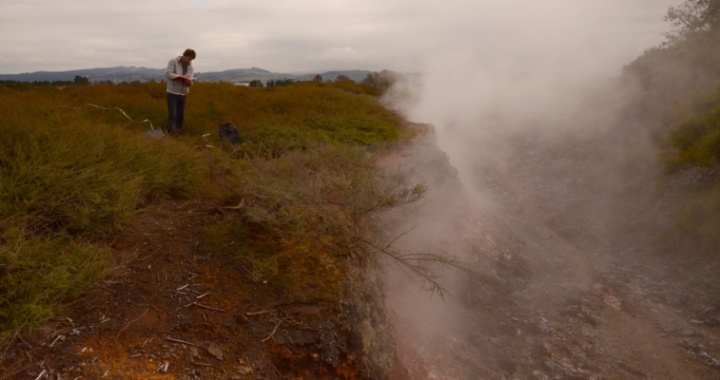Swapping Time For Space To Track The Impact Of Microbes On Climate Change
Whether soils lose or gain carbon under warming temperatures remains one of the significant unknowns in climate change studies. In breakthrough research, Manaaki Whenua – Landcare researchers Manpreet Dhami and Gabriel Moinet have made an important finding about the response of microbes to increasing soil temperatures.

Gabriel Moinet sampling at the edge of the steam-heated depression, a geo-thermal feature near Taupō
Microbes are vital to the decomposition of organic material – a process that releases carbon into the atmosphere. Therefore, the ability to measure if the physiological response of microbes to warmer temperatures results in higher carbon dioxide levels will help predict the rate of this release. Evidence from short-term experiments show this physiological response results in higher carbon release from decomposing organic matter.
The challenge for researchers has always been how best to record this potential shift in microbial response over a timeframe that is truly representative of climate change. After all, “you can’t make climate change happen in a test tube in a lab over a few hours, or a few days,” says Moinet.
To replicate the effects of warming temperatures on microbes, Dhami and Moinet decided a “conceptual trick” was needed and that they could swap time – specifically geological time for space.
They identified a steam-heated depression in a field near Taupō, a volcanic area in New Zealand’s North Island that provided the perfect environment for their research.
“It’s a geothermal feature that allowed us to sample along a transect from the hottest areas closest to it all the way to the cool areas further out,” says Moinet.
“The gradient mimics what would happen to the soil in different climate warming scenarios over very long periods of time. This allowed us to sample the microbes along the transect and see if, and how, they adapted and measure what, if any, physiological differences there were in response to changing temperatures.”
Using this creative concept, Moinet and Dhami were able to show that while communities of microbes in the soil do adapt in response to temperature, their physiological response remains the same. “In our research, it appears that the physiological response to temperature in warm-adapted microbes (thermophiles) and mesophiles was the same, If this is confirmed at other sites and other conditions, that means that predicting the microbial feedback to climate change can be done from short-term studies after all,” says Dhami.
As well as having having access to a unique geothermal environment, a game changer for this area of research, Dhami a microbiologist, and Moinet a soil scientist, built a mobile molecular lab that was towed to Taupō. The lab was set up complete with pipettes, sterilised bench and DNA extraction tubes, in the field to collect samples.
Moinet, an Assistant Professor now based at the University of Wageningen in the Netherlands, says these findings bring them a little bit closer to fully understanding the role soil plays in climate change.
“Because soil systems are so complex, there is a greater need for a multidisciplinary approach, such as this study, that looks at the system as a whole and is not compartmentalised by discipline,” says Moinet.
Dhami agrees: “Our unique approach combined our expertise so there was both the detailed microbial community composition study, as well as a state-of-the-art assessment of the physiological response.”
She says the success of this research, which only looked at the adaptive responses of community composition in warming soils, shows the scope to look at other microbial genes. “Temperature is only one of the factors that’s part of the bigger climate change picture. But this is a start.”


 NZ Banking Association: Banks Step Up Customer Scam Protections And Compensation
NZ Banking Association: Banks Step Up Customer Scam Protections And Compensation The Reserve Bank of New Zealand: CoFR Seeking Feedback On Access To Basic Transaction Accounts
The Reserve Bank of New Zealand: CoFR Seeking Feedback On Access To Basic Transaction Accounts 2Degrees: Stop The Pings - Half Of Kiwis Overwhelmed By Notifications
2Degrees: Stop The Pings - Half Of Kiwis Overwhelmed By Notifications Electricity Networks Association: How Many More Trees Need To Fall On Power Lines Before The Rules Change?
Electricity Networks Association: How Many More Trees Need To Fall On Power Lines Before The Rules Change? Parrot Analytics: Netflix Earnings - Price Hikes With Minimal Churn | Will Netflix Be A Bright Spot For Markets?
Parrot Analytics: Netflix Earnings - Price Hikes With Minimal Churn | Will Netflix Be A Bright Spot For Markets? Canterbury Museum: Mystery Molars Lead To Discovery Of Giant Crayfish In Ancient Aotearoa New Zealand
Canterbury Museum: Mystery Molars Lead To Discovery Of Giant Crayfish In Ancient Aotearoa New Zealand



